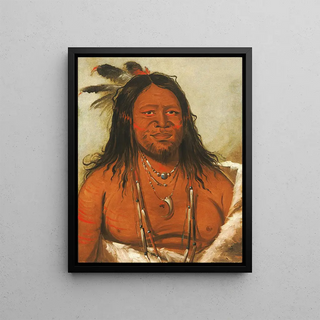Art print | Ta-Wh-Que-Nah Mountain of Rocks Second Chief of the Tribe - George Catlin


View from behind

Frame (optional)
George Catlin's artwork "Ta-Wh-Que-Nah Mountain of Rocks Second Chief of the Tribe" is much more than a simple painting; it embodies a captivating encounter between art and Native American cultures. Through this piece, Catlin invites us to delve into the universe of indigenous tribes, revealing their beauty, strength, and wisdom. In a context where the traditions and lifestyles of indigenous peoples were often misunderstood or misinterpreted, this representation serves as a vibrant tribute to the cultural richness of these communities. Every brushstroke tells a story, every color evokes an emotion, and every detail transports us to a world where harmony between man and nature is omnipresent.
Style and uniqueness of the work
George Catlin's style is distinguished by its striking realism and meticulous attention to detail. In "Ta-Wh-Que-Nah Mountain of Rocks Second Chief of the Tribe," the artist manages to capture not only the physical appearance of his subject but also the very essence of their identity. The vibrant colors and rich textures, typical of his work, help create an immersive atmosphere. Catlin uses a palette of earthy tones that evoke the natural landscape while highlighting the dignity and nobility of his subject. The proud posture of the chief, along with the symbolic elements present in the composition, testify to the spirituality and beliefs of indigenous peoples. This artwork also stands out for its empathetic approach, allowing the viewer to feel a deep connection with the depicted character.
The artist and his influence
George Catlin, an unwavering artist and traveler, dedicated a significant part of his life to documenting Native American cultures. His work is not only an artistic testimony but also a valuable historical document. Traveling across the American continent, he had the opportunity to meet numerous tribes, learn their customs, and understand their struggles. His commitment to preserving their heritage through art has had a lasting impact on the perception of indigenous cultures. Catlin not only paved the way for a

Matte finish

View from behind

Frame (optional)
George Catlin's artwork "Ta-Wh-Que-Nah Mountain of Rocks Second Chief of the Tribe" is much more than a simple painting; it embodies a captivating encounter between art and Native American cultures. Through this piece, Catlin invites us to delve into the universe of indigenous tribes, revealing their beauty, strength, and wisdom. In a context where the traditions and lifestyles of indigenous peoples were often misunderstood or misinterpreted, this representation serves as a vibrant tribute to the cultural richness of these communities. Every brushstroke tells a story, every color evokes an emotion, and every detail transports us to a world where harmony between man and nature is omnipresent.
Style and uniqueness of the work
George Catlin's style is distinguished by its striking realism and meticulous attention to detail. In "Ta-Wh-Que-Nah Mountain of Rocks Second Chief of the Tribe," the artist manages to capture not only the physical appearance of his subject but also the very essence of their identity. The vibrant colors and rich textures, typical of his work, help create an immersive atmosphere. Catlin uses a palette of earthy tones that evoke the natural landscape while highlighting the dignity and nobility of his subject. The proud posture of the chief, along with the symbolic elements present in the composition, testify to the spirituality and beliefs of indigenous peoples. This artwork also stands out for its empathetic approach, allowing the viewer to feel a deep connection with the depicted character.
The artist and his influence
George Catlin, an unwavering artist and traveler, dedicated a significant part of his life to documenting Native American cultures. His work is not only an artistic testimony but also a valuable historical document. Traveling across the American continent, he had the opportunity to meet numerous tribes, learn their customs, and understand their struggles. His commitment to preserving their heritage through art has had a lasting impact on the perception of indigenous cultures. Catlin not only paved the way for a






